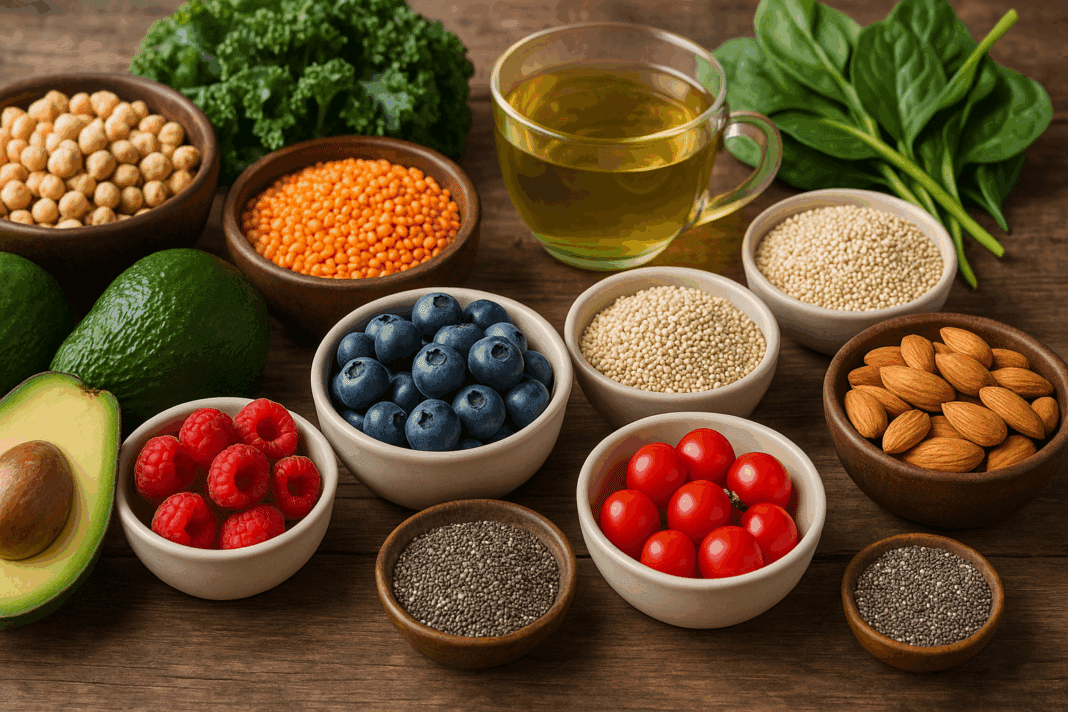In a world where quick-fix diets and extreme regimens often promise unrealistic outcomes, the science of sustainable weight loss continues to underscore a much simpler, evidence-based approach: the quality of the food we consume. Nutrient-dense foods that are naturally rich in fiber, antioxidants, vitamins, minerals, and healthy fats play a crucial role in supporting metabolism, enhancing satiety, and promoting long-term health. These foods are often referred to as superfoods. When strategically incorporated into a balanced eating pattern, these superfoods for weight loss can support healthy fat loss without compromising nutritional needs or energy levels.
You may also like: Expert-Backed Weight Loss Tips for a Healthier Lifestyle: What You Need to Know for Long-Term Weight Control and Wellness
While the term “superfood” may evoke images of exotic berries or niche powders, the concept is more grounded in biochemistry and metabolic function than in marketing hype. Superfoods for weight loss are not magical cures but rather deeply nourishing choices that contribute to calorie control, hormonal balance, improved digestion, and enhanced thermogenesis. Scientific studies have increasingly shown that certain whole foods do more than simply provide nutrients—they actively participate in metabolic pathways that encourage fat oxidation and reduce inflammation, both key components in sustainable weight management.
Understanding the scientific basis behind superfoods for weight loss allows us to move beyond fads and focus on foods that deliver measurable benefits. Whether it is the soluble fiber in oats that regulates blood sugar or the catechins in green tea that enhance fat metabolism, each of these superfoods operates through specific physiological mechanisms. This article explores some of the most thoroughly studied and widely recommended super foods for weight loss, offering insights into how they work and how to integrate them into your daily routine.
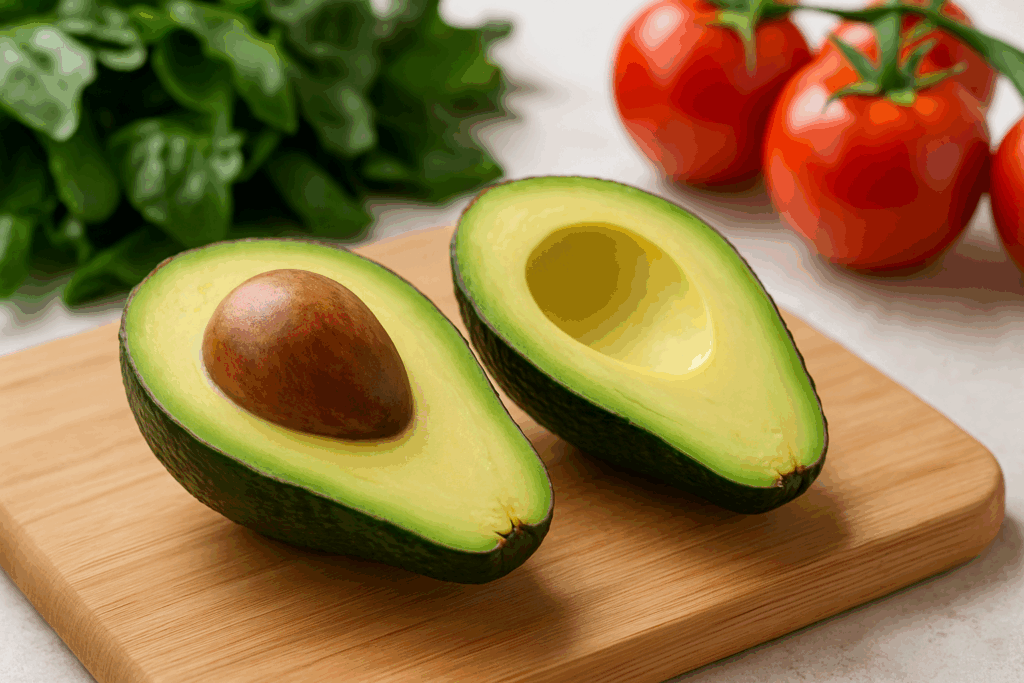
Avocados: Healthy Fats That Curb Hunger and Support Metabolism
Avocados often challenge traditional views of dieting because they are high in fat—yet it’s precisely this nutritional composition that makes them a standout among superfoods for weight loss. Rich in monounsaturated fatty acids, particularly oleic acid, avocados help increase satiety and reduce overall calorie intake. Studies published in journals like the Nutrition Journal have shown that people who include avocado in their meals report feeling more satisfied and are less likely to snack later in the day.
Beyond satiety, the healthy fats in avocados support fat metabolism and assist in the absorption of fat-soluble vitamins such as A, D, E, and K. These vitamins play a vital role in metabolic function, immune health, and even hormonal balance. In addition, avocados are a good source of dietary fiber, particularly soluble fiber, which further enhances their ability to support digestive health and moderate insulin response—both essential for sustainable weight loss.
What sets avocados apart is their versatility. Whether added to smoothies, sliced onto toast, or blended into dressings, they can be incorporated into virtually any meal. Their creamy texture and rich flavor also make them a satisfying alternative to less nutritious fats, such as processed oils or high-calorie spreads. The inclusion of avocados in a well-balanced diet not only aligns with the principles of preventive nutrition but also fits seamlessly into many evidence-based weight loss strategies.
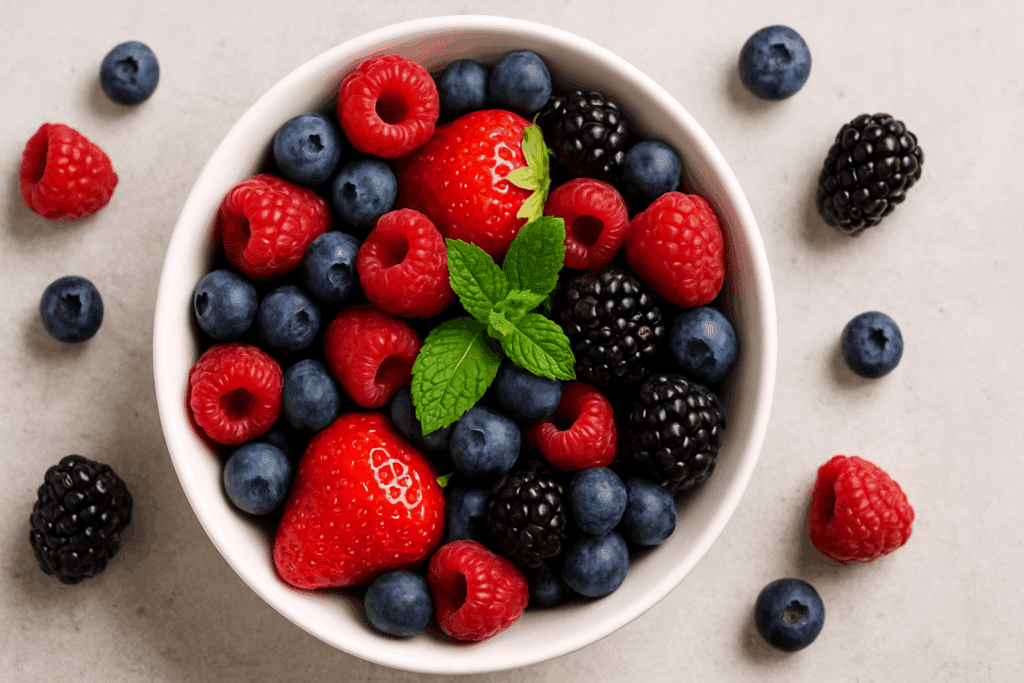
Berries: Antioxidant Powerhouses That Help Regulate Blood Sugar
Blueberries, raspberries, blackberries, and strawberries have long been hailed for their vibrant color and tangy sweetness, but their true power lies in their phytochemical content. Berries are packed with antioxidants such as anthocyanins, ellagic acid, and flavonoids that help combat oxidative stress and reduce systemic inflammation, both of which are often elevated in individuals with obesity. The reduction of inflammation can improve insulin sensitivity, which is essential for effective fat metabolism.
These fruits also rank low on the glycemic index and contain high levels of fiber, which helps to regulate blood glucose levels and reduce cravings. Clinical studies have demonstrated that regular consumption of berries can significantly improve glucose metabolism, particularly in individuals with insulin resistance or type 2 diabetes. This makes berries not only a flavorful treat but a strategic inclusion in any diet aimed at long-term weight management.
Another unique advantage of berries is their polyphenol content, which may play a role in modulating the gut microbiota—a factor increasingly linked to metabolic health and obesity risk. By promoting the growth of beneficial gut bacteria, berries can contribute to a more balanced internal environment that supports efficient energy usage and fat storage regulation. This multifaceted functionality underscores why berries are consistently recommended as superfoods for weight loss by registered dietitians and nutrition scientists alike.
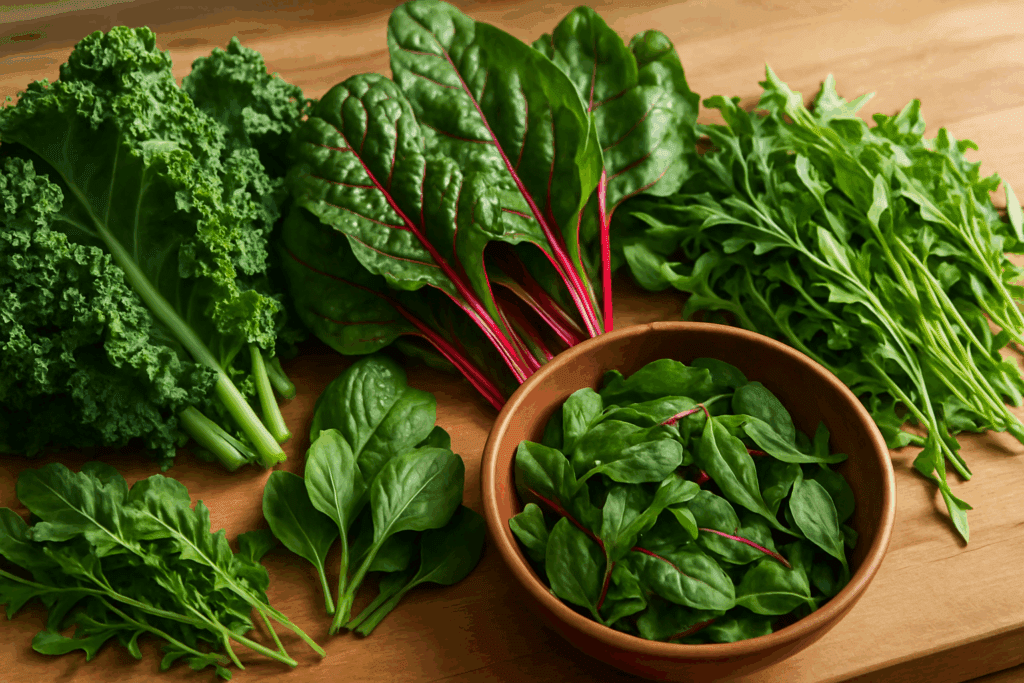
Leafy Greens: Low-Calorie Nutrient Density That Supports Detoxification
When it comes to superfoods for weight loss, few can rival the nutrient-to-calorie ratio offered by leafy greens. Spinach, kale, Swiss chard, arugula, and collard greens are exceptionally low in calories yet rich in essential nutrients such as magnesium, potassium, folate, and vitamin C. These micronutrients support enzymatic processes that aid in fat oxidation, muscle function, and fluid balance—all vital to a healthy metabolism.
Leafy greens are also packed with chlorophyll, a natural detoxifier that helps the body eliminate waste products through the liver. While the concept of detoxing is often misrepresented in popular media, legitimate biochemical detoxification does occur in the liver and kidneys, and is enhanced by the availability of certain micronutrients and phytochemicals. By supporting these natural processes, leafy greens help the body operate more efficiently, which can in turn support weight loss goals.
In addition, the high fiber content of leafy greens improves gastrointestinal motility and fosters a sense of fullness. Unlike refined grains or processed foods, greens provide bulk without added calories, allowing individuals to consume larger portions while still maintaining a calorie deficit. The inclusion of leafy greens in smoothies, salads, soups, or sautéed dishes is a practical, evidence-based strategy for increasing nutrient density without increasing caloric load.
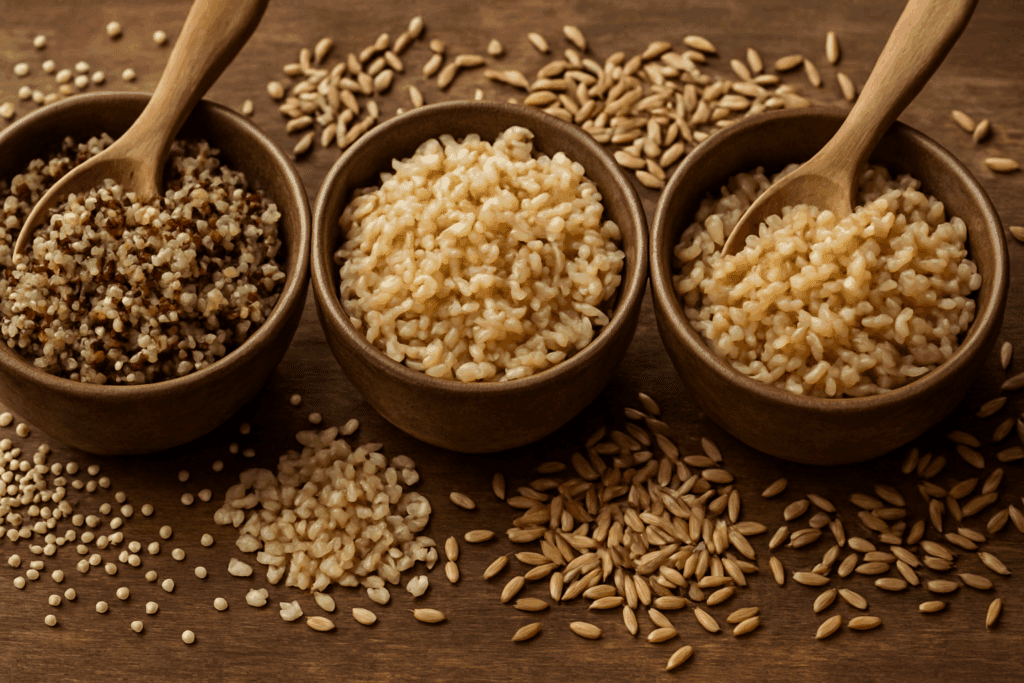
Whole Grains: Fiber-Rich Superfoods That Improve Satiety and Metabolic Health
Whole grains such as quinoa, brown rice, oats, barley, and farro have earned their place on the list of super foods for weight loss due to their rich fiber content and complex carbohydrate structure. Unlike refined grains that spike blood sugar and offer little nutritional value, whole grains digest slowly and release energy gradually. This prevents insulin surges and supports a more stable metabolic rate throughout the day.
Dietary fiber plays a central role in regulating appetite hormones such as ghrelin and leptin. By slowing gastric emptying and promoting the release of satiety signals, fiber-rich foods help individuals naturally consume fewer calories without experiencing deprivation. Additionally, whole grains contain resistant starch, which acts as a prebiotic, feeding the beneficial bacteria in the gut. This gut-brain connection has emerged as a key player in the regulation of body weight and mood-related eating behaviors.
Research from institutions like Harvard’s T.H. Chan School of Public Health supports the notion that diets rich in whole grains are associated with lower body mass index (BMI) and reduced risk of chronic diseases such as heart disease and type 2 diabetes. This intersection of weight management and long-term health reinforces the role of whole grains as essential superfoods for weight loss when consumed in appropriate portions and prepared without excessive added fats or sugars.

Green Tea: Thermogenic Support Through Natural Compounds
Green tea is a staple in many cultures and has long been revered for its health-promoting properties, but it also plays a distinct role in supporting fat metabolism. The key compound responsible for this effect is epigallocatechin gallate (EGCG), a catechin that has been shown to increase the body’s thermogenic response and enhance fat oxidation, particularly during exercise.
In addition to its thermogenic properties, green tea contains moderate levels of caffeine, which can help increase alertness and physical performance. Together, these compounds work synergistically to boost energy expenditure and improve metabolic efficiency. Studies published in the American Journal of Clinical Nutrition have shown that green tea extract can significantly enhance fat burning, especially in the abdominal area.
Green tea also exerts a positive effect on insulin sensitivity and blood glucose control, which helps mitigate the kind of erratic hunger and energy crashes often associated with high-sugar diets. Regular consumption of green tea as part of a comprehensive dietary strategy can complement other superfoods for weight loss, offering a natural and enjoyable beverage choice that supports the body’s metabolic needs.
Legumes: Protein and Fiber in One Powerhouse Package
Beans, lentils, chickpeas, and peas are among the most underrated superfoods for weight loss. These legumes are rich in both protein and soluble fiber, a rare combination that makes them exceptionally filling and metabolically advantageous. Consuming legumes has been linked to improved appetite control, reduced LDL cholesterol, and enhanced gut health.
Unlike animal-based proteins that may be high in saturated fat, legumes offer a plant-based alternative that delivers essential amino acids without the added calories or cardiovascular risks. Their low glycemic index makes them suitable for blood sugar management, and their prebiotic fiber supports a thriving gut microbiome. This is especially important because an imbalanced microbiome can contribute to chronic inflammation and metabolic sluggishness.
Studies have shown that incorporating legumes into meals can reduce overall caloric intake by promoting fullness and delaying the return of hunger. Their versatility—whether used in soups, stews, salads, or dips—makes them easy to include in diverse meal plans. As whole, unprocessed foods, legumes align well with evidence-based recommendations for sustainable and healthy fat loss.
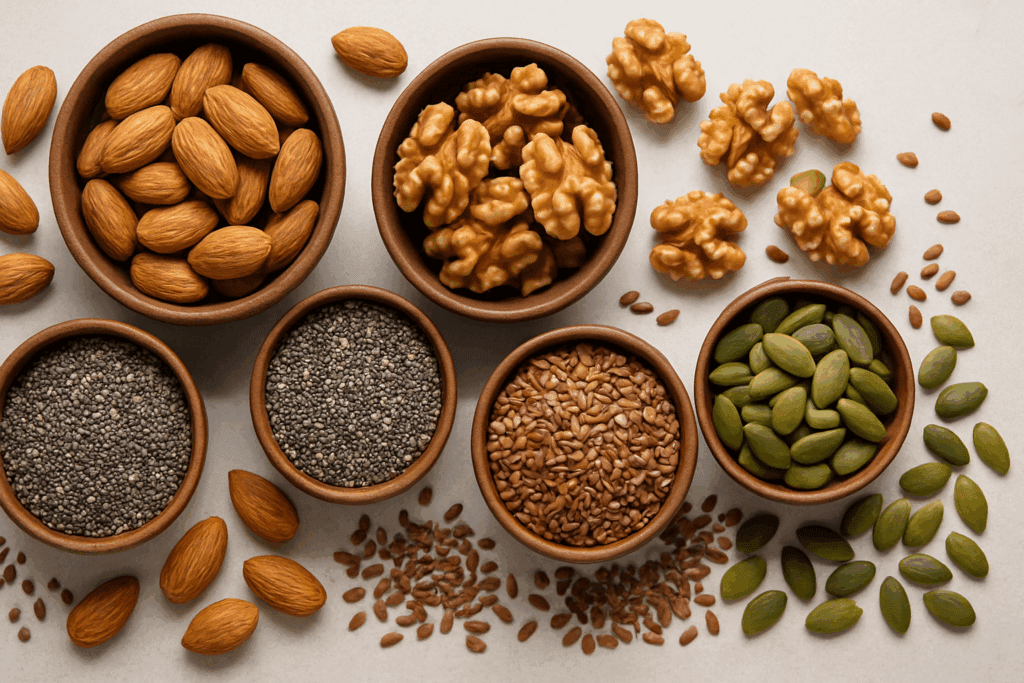
Nuts and Seeds: Compact Nutritional Density With Appetite Control Benefits
Almonds, walnuts, chia seeds, flaxseeds, and pumpkin seeds may be small, but they pack a significant nutritional punch. These nutrient-dense foods are high in healthy fats, plant-based protein, and fiber, all of which contribute to prolonged satiety and stable energy levels. Despite their caloric density, multiple studies have demonstrated that individuals who regularly consume nuts and seeds tend to have healthier body weights and reduced central adiposity.
The combination of omega-3 fatty acids, magnesium, and antioxidant compounds in nuts and seeds supports not only weight loss but also cardiovascular health, cognitive function, and hormone regulation. Chia seeds, for instance, can absorb up to 10 times their weight in water, forming a gel-like substance that expands in the stomach and delays gastric emptying. This contributes to a feeling of fullness and reduces the likelihood of overeating.
Because of their high caloric density, portion control is important when integrating nuts and seeds into a weight loss plan. A small handful can provide a satisfying, nutrient-rich snack that bridges the gap between meals without triggering blood sugar spikes. These properties make nuts and seeds some of the most practical and effective super foods for weight loss available in a modern dietary toolkit.
Frequently Asked Questions (FAQ): Superfoods for Weight Loss
1. Can superfoods for weight loss help improve gut health as well?
Yes, many superfoods for weight loss offer dual benefits that extend beyond fat reduction to gut microbiome support. For instance, foods like legumes, chia seeds, and berries contain prebiotic fibers that feed beneficial gut bacteria. A balanced gut flora not only improves digestion but also enhances nutrient absorption and reduces systemic inflammation, which can contribute to easier weight control. Super foods for weight loss that influence gut health have been shown to positively affect hormonal signaling, particularly hormones that regulate hunger and satiety. Thus, including gut-friendly superfoods can create a more holistic and metabolically favorable environment for sustainable fat loss.
2. How do superfoods for weight loss impact hormone regulation?
Some of the most effective superfoods for weight loss actively influence hormonal balance. Avocados, for example, help modulate cortisol levels due to their high content of monounsaturated fats and vitamin B6. Cruciferous vegetables like kale and broccoli support estrogen metabolism, which can be particularly beneficial for women with hormonal imbalances. Furthermore, high-fiber super foods for weight loss slow glucose absorption, thereby reducing insulin spikes that contribute to fat storage. By stabilizing hormones like insulin, leptin, and ghrelin, superfoods create a more balanced internal environment that supports appetite regulation and metabolic efficiency.
3. Are superfoods for weight loss suitable for people with metabolic syndrome or prediabetes?
Absolutely, many superfoods for weight loss are ideal for individuals managing metabolic disorders. Green leafy vegetables, berries, and whole grains offer low glycemic loads, which can help stabilize blood sugar. Nutrient-dense foods like legumes also promote improved insulin sensitivity through their combination of fiber, protein, and micronutrients like magnesium. Including super foods for weight loss in a carefully designed diet can significantly reduce the risk of developing type 2 diabetes while also supporting weight loss goals. In fact, clinical trials often recommend these foods as part of dietary interventions for reversing insulin resistance.
4. How do superfoods for weight loss differ from standard healthy foods?
While all healthy foods provide nutrients, superfoods for weight loss offer concentrated benefits that specifically target fat metabolism and satiety. What distinguishes them is their ability to trigger thermogenesis, enhance gut health, and modulate hormones more effectively than general food options. For example, quinoa not only supplies complex carbohydrates but also contains all nine essential amino acids, supporting muscle retention during calorie deficits. Likewise, green tea isn’t just a hydrating beverage but a thermogenic stimulant thanks to catechins like EGCG. These targeted physiological benefits elevate certain nutrient-dense items into the category of super foods for weight loss.
5. Can I rely solely on superfoods for weight loss without changing my lifestyle?
Relying exclusively on superfoods for weight loss without addressing lifestyle factors such as exercise, sleep, and stress management is unlikely to produce lasting results. While these foods play a foundational role in supporting metabolic health, their effectiveness is magnified when combined with other healthy habits. Regular physical activity enhances the body’s ability to utilize the nutrients found in superfoods, while adequate sleep helps maintain hormonal balance. Super foods for weight loss work best as part of a comprehensive lifestyle plan that also includes mindful eating and physical wellness practices. Thinking of them as tools rather than cures is key to long-term success.
6. Do superfoods for weight loss offer mental health benefits too?
Emerging research indicates that many superfoods for weight loss also support cognitive function and emotional well-being. Foods like walnuts and chia seeds provide omega-3 fatty acids, which are known to reduce symptoms of depression and anxiety. Additionally, antioxidant-rich berries may improve neuroplasticity and reduce age-related cognitive decline. The gut-brain axis plays a role as well, with prebiotic fibers from certain super foods for weight loss improving gut health and indirectly influencing mood. In this way, choosing these foods may simultaneously benefit your mind and waistline.
7. How do cultural dietary patterns influence the effectiveness of super foods for weight loss?
Cultural traditions often incorporate superfoods that support weight management, though they may not be labeled as such. For example, fermented foods like kimchi or miso in East Asian diets promote gut health and digestion, while legumes in Mediterranean cuisine provide fiber and plant-based protein. The contextual preparation of super foods for weight loss also matters—steaming versus frying, for instance, can dramatically impact their nutritional integrity. Adapting superfoods to align with one’s cultural cuisine increases dietary compliance and improves long-term outcomes. Recognizing the traditional roots of many superfoods adds both historical depth and culinary diversity to a weight-loss plan.
8. Are there seasonal advantages to consuming superfoods for weight loss?
Eating seasonal super foods for weight loss can offer enhanced nutritional potency and affordability. Berries harvested in summer, for instance, tend to have higher antioxidant levels than those stored for months or imported. Similarly, winter squashes provide complex carbohydrates and fiber that support satiety during colder months when energy needs may rise. Aligning your intake of superfoods for weight loss with the seasons also supports biodiversity and encourages a varied diet, which helps prevent nutrient gaps. Seasonal eating creates a more sustainable and nutritionally rich approach to healthy weight loss.
9. What role do superfoods for weight loss play in muscle preservation during fat loss?
A common concern during weight loss is muscle catabolism, which can be mitigated by including high-protein super foods for weight loss. Foods such as quinoa, Greek yogurt, and legumes provide essential amino acids that support muscle synthesis even in a calorie deficit. Muscle preservation is critical not just for strength but for maintaining resting metabolic rate, which influences long-term weight control. Nutrients like magnesium and potassium in leafy greens also support muscle function and recovery. Strategically choosing superfoods that promote muscle health can amplify fat loss while preserving lean tissue.
10. What are some practical tips for incorporating superfoods for weight loss into a busy lifestyle?
Incorporating superfoods for weight loss doesn’t have to be time-consuming or complicated. Meal prepping quinoa or lentils in bulk allows for quick, nutritious base ingredients throughout the week. Keeping frozen berries or pre-washed leafy greens on hand makes it easy to assemble nutrient-dense smoothies or salads in minutes. Healthy snacks like almonds or chia seed pudding can be pre-portioned to avoid impulsive eating. Small shifts, such as replacing soda with green tea or white rice with farro, introduce super foods for weight loss without overhauling your entire routine. With a little planning, these nutrient powerhouses can fit seamlessly into even the busiest schedules.
Conclusion: Why Choosing the Right Superfoods for Weight Loss Matters More Than Ever
In a nutritional landscape often clouded by conflicting advice and commercialized diet trends, turning to superfoods for weight loss offers a science-backed, sustainable pathway toward achieving and maintaining a healthy body weight. The foods discussed in this article are not only rich in essential nutrients but also engage the body’s metabolic and hormonal systems in ways that enhance fat loss and overall wellness. Unlike highly restrictive diets or gimmicky supplements, these whole, nutrient-dense foods provide lasting benefits that extend far beyond the number on the scale.
By focusing on super foods for weight loss such as avocados, berries, leafy greens, whole grains, green tea, legumes, and nuts, individuals can build a dietary foundation rooted in evidence, not marketing. These foods work synergistically to curb hunger, regulate blood sugar, reduce inflammation, and optimize metabolism—creating an internal environment that supports fat loss naturally and effectively. When these superfoods are part of a balanced, plant-forward diet combined with regular physical activity and mindful eating habits, the potential for sustainable transformation becomes not just possible but practical.
As we continue to learn more about the intricate relationship between diet, metabolism, and long-term health, the role of superfoods becomes even more relevant. They exemplify how food can be both nourishing and therapeutic, allowing us to take control of our health in a way that is both evidence-based and empowering. With the right knowledge and approach, superfoods for weight loss can become powerful allies in the journey toward better health, enhanced energy, and lifelong wellness.
Further Reading:
20 Best Superfoods for Weight Loss
Top Superfoods for Weight Loss Success
15 Superfoods for Weight Loss: The Ultimate Indian Diet Plan


